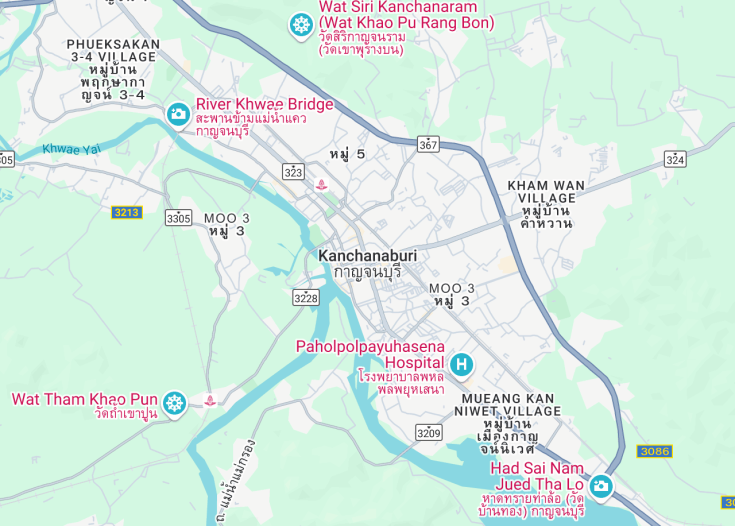Kanchanaburi, Thailand, is a compelling destination steeped both in natural beauty and historical significance. Most renowned for the River Kwai and its haunting WWII history, the region offers an array of attractions from pristine national parks and waterfalls to poignant war memorials and museums. This locale not only caters to history enthusiasts but also to nature lovers and adventure seekers, making it a versatile getaway. Kanchanaburi’s tranquil riverside settings are juxtaposed with vibrant night markets and local cuisine, offering a complete Thai cultural experience.
When visiting Kanchanaburi, always plan to attend the River Kwai Bridge Week in late November, featuring historical exhibitions and light-and-sound shows.
To fully appreciate the natural beauty of Kanchanaburi, consider staying overnight in a floating hotel on the River Kwai, offering unique views and experiences.
Top things to do & see in Kanchanaburi
Select the following sights and activities to discover best tickets and tours available in Kanchanaburi.
Kanchanaburi: Gateway to Thailand’s Natural and Historic Wonders
| Country | Thailand |
| Time in Kanchanaburi | GMT+7 |
| Language spoken | Thai |
| Population | 31,000 (World Population Review 2023) |
| Currency | Thai Baht (฿, THB) |
| Airports |
|
Kanchanaburi, a province in Western Thailand, is renowned for its historical significance and captivating landscapes. This provincial capital offers a poignant reminder of World War II through the infamous Death Railway, Bridge over the River Kwai, and numerous war museums. Beyond its historical allure, Kanchanaburi is endowed with lush national parks, waterfalls, and caves, making it a prime destination for nature lovers and history enthusiasts alike. The area is surrounded by dense jungles and protected wildlife reserves, offering ample trekking, kayaking, and wildlife sighting opportunities.
Where is Kanchanaburi?
Kanchanaburi is located in Western Thailand, approximately 80 miles west of Bangkok, bordered by Myanmar to the north and west.
Distances:
| Route | Distance by car | Time by car |
|---|---|---|
| Bangkok to Kanchanaburi | 80 miles | 2 hours |
| Ayutthaya to Kanchanaburi | 90 miles | 2 hours 20 minutes |
| Hua Hin to Kanchanaburi | 150 miles | 3 hours 45 minutes |
What is Kanchanaburi famous for?
Kanchanaburi is most famous for its historical WWII sites, including the Bridge over the River Kwai and the Death Railway, which attract history buffs and adventure travelers from around the world.
History
Pre-History to 13th Century
Kanchanaburi, located in Thailand, has a rich tapestry of history that traces back to prehistoric times. Archaeological remnants suggest that the area was inhabited by Neolithic communities who lived along the banks of the Kwai River, using the fertile land for agriculture and fishing. As centuries progressed, several small states and principalities emerged, often influenced by the dominant powers of the region, including the Khmer Empire.
14th Century to 18th Century
By the Ayutthaya period beginning in the 14th century, Kanchanaburi was recognized as a strategic military outpost. It served as a buffer zone against Burmese incursions, given its location near the Thai-Myanmar border. During this time, it was also a center of trade, especially in timber and gems, which were abundant in the surrounding mountains and rivers.
19th Century to World War II
The significance of Kanchanaburi grew during the Bangkok Period when King Rama I integrated the region more closely into the kingdom of Siam. The establishment of railways in the 19th century brought more development but also challenges. World War II marked a particularly dark chapter in Kanchanaburi’s history with the construction of the infamous Death Railway by Japanese forces using forced labor, including prisoners of war and Asian conscripts.
Post World War II to Present Day
In the post-war years, Kanchanaburi transitioned from a site of suffering to one of remembrance and tourism. Memorials and museums dedicated to the Death Railway’s victims draw visitors from around the globe. Today, Kanchanaburi is not only a place of historical significance but also a hub for ecotourism, leveraging its stunning natural landscapes, wildlife sanctuaries, and national parks like Erawan and Sai Yok.
Visit Kanchanaburi
What to see and do in Kanchanaburi
Visiting Kanchanaburi, travelers can dive into both its natural and historical richness. Key points of interest include:
- The Bridge over the River Kwai, an iconic symbol of World War II’s history.
- Erawan National Park, famed for its stunning waterfalls and hiking trails.
- The JEATH War Museum, which offers deep insights into the plight of those who toiled on the Death Railway.
- Sai Yok National Park, known for its scenic river views and waterfalls.
- Hellfire Pass Memorial Museum, a tribute to the harsh realities faced by POWs during the railway’s construction.
Each site offers a unique perspective of Kanchanaburi’s multifaceted identity, bridging the past with natural beauty.
Festivals and Events in Kanchanaburi
Kanchanaburi hosts several cultural and historical events throughout the year, notable among them being the River Kwai Bridge Week in November, commemorating the history of the Death Railway and featuring light and sound performances, exhibitions, and historical re-enactments.
Best time to visit Kanchanaburi
The ideal time to visit Kanchanaburi is during the cooler months from November to February when the weather is most pleasant, making it perfect for exploring the outdoor attractions and historical sites.
Is Kanchanaburi worth visiting?
Kanchanaburi is undoubtedly worth visiting for those who appreciate both nature and history. The town offers a unique blend of breathtaking natural landscapes and poignant historical markers that provide deep insights into human resilience and history. Whether you are an outdoor enthusiast or a history buff, Kanchanaburi presents a valuable and enriching experience.









